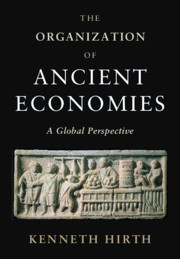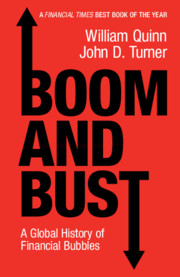Refine search
Actions for selected content:
26946 results in Economic history
Trade, Finance, and Industry in the Development of Indian Capitalism: The Case of Tata
-
- Journal:
- Business History Review / Volume 94 / Issue 3 / Autumn 2020
- Published online by Cambridge University Press:
- 04 September 2020, pp. 569-592
- Print publication:
- Autumn 2020
-
- Article
- Export citation

The Organization of Ancient Economies
- A Global Perspective
-
- Published online:
- 31 August 2020
- Print publication:
- 17 September 2020
RHE volume 38 issue 2 Cover and Back matter
-
- Journal:
- Revista de Historia Economica - Journal of Iberian and Latin American Economic History / Volume 38 / Issue 2 / September 2020
- Published online by Cambridge University Press:
- 28 August 2020, pp. b1-b3
- Print publication:
- September 2020
-
- Article
-
- You have access
- Export citation
RHE volume 38 issue 2 Cover and Front matter
-
- Journal:
- Revista de Historia Economica - Journal of Iberian and Latin American Economic History / Volume 38 / Issue 2 / September 2020
- Published online by Cambridge University Press:
- 28 August 2020, pp. f1-f4
- Print publication:
- September 2020
-
- Article
-
- You have access
- Export citation
INTRODUCTION
-
- Journal:
- Revista de Historia Economica - Journal of Iberian and Latin American Economic History / Volume 38 / Issue 2 / September 2020
- Published online by Cambridge University Press:
- 28 August 2020, pp. 215-219
- Print publication:
- September 2020
-
- Article
- Export citation
THE KUZNETS CURVE IN BRAZIL, 1850-2010
-
- Journal:
- Revista de Historia Economica - Journal of Iberian and Latin American Economic History / Volume 39 / Issue 1 / March 2021
- Published online by Cambridge University Press:
- 26 August 2020, pp. 37-61
- Print publication:
- March 2021
-
- Article
- Export citation
Keynes, inflation and the public debt: How to Pay for the War as a policy prescription for financial repression?
-
- Journal:
- Financial History Review / Volume 27 / Issue 2 / August 2020
- Published online by Cambridge University Press:
- 18 August 2020, pp. 187-209
-
- Article
-
- You have access
- Open access
- HTML
- Export citation
The rise of financial accountability in British joint stock banks: 1825 to 1845
-
- Journal:
- Financial History Review / Volume 27 / Issue 2 / August 2020
- Published online by Cambridge University Press:
- 18 August 2020, pp. 234-255
-
- Article
- Export citation

Boom and Bust
- A Global History of Financial Bubbles
-
- Published online:
- 06 August 2020
- Print publication:
- 06 August 2020
Chapter 4 - Democratising Speculation: The Great Railway Mania
-
- Book:
- Boom and Bust
- Published online:
- 06 August 2020
- Print publication:
- 06 August 2020, pp 58-76
-
- Chapter
- Export citation
Notes
-
- Book:
- Boom and Bust
- Published online:
- 06 August 2020
- Print publication:
- 06 August 2020, pp 225-256
-
- Chapter
- Export citation
Copyright page
-
- Book:
- Boom and Bust
- Published online:
- 06 August 2020
- Print publication:
- 06 August 2020, pp iv-iv
-
- Chapter
- Export citation
Chapter 11 - Casino Capitalism with Chinese Characteristics
-
- Book:
- Boom and Bust
- Published online:
- 06 August 2020
- Print publication:
- 06 August 2020, pp 193-209
-
- Chapter
- Export citation
Chapter 8 - Blowing Bubbles for Political Purposes: Japan in the 1980s
-
- Book:
- Boom and Bust
- Published online:
- 06 August 2020
- Print publication:
- 06 August 2020, pp 134-151
-
- Chapter
- Export citation
Figures
-
- Book:
- Boom and Bust
- Published online:
- 06 August 2020
- Print publication:
- 06 August 2020, pp vi-vii
-
- Chapter
- Export citation
Chapter 10 - ‘No More Boom and Bust’: The Subprime Bubble
-
- Book:
- Boom and Bust
- Published online:
- 06 August 2020
- Print publication:
- 06 August 2020, pp 170-192
-
- Chapter
- Export citation
Chapter 12 - Predicting Bubbles
-
- Book:
- Boom and Bust
- Published online:
- 06 August 2020
- Print publication:
- 06 August 2020, pp 210-222
-
- Chapter
- Export citation
Chapter 5 - Other People’s Money: The Australian Land Boom
-
- Book:
- Boom and Bust
- Published online:
- 06 August 2020
- Print publication:
- 06 August 2020, pp 77-97
-
- Chapter
- Export citation
Index
-
- Book:
- Boom and Bust
- Published online:
- 06 August 2020
- Print publication:
- 06 August 2020, pp 282-288
-
- Chapter
- Export citation
Chapter 1 - The Bubble Triangle
-
- Book:
- Boom and Bust
- Published online:
- 06 August 2020
- Print publication:
- 06 August 2020, pp 1-15
-
- Chapter
- Export citation
